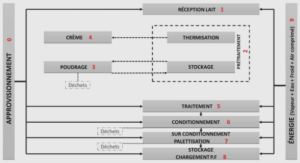Procédés d’impression 3D de pâte et matériau céréalier et séchage
des matériaux post-impression
Impression à chaud des pâtes et matériaux à base de farine de blé Impression à chaud de la pâte de farine de blé obtenue par traitement mécanique L’impression à chaud a été étudiée dans le but de structurer par traitement thermique la pâte à 55% (p/p) d’eau obtenue par traitement mécanique.
Les résultats de ces travaux ont été acceptés et seront publiés dans le «Proceedings of the 22nd International Drying Symposium». Cette publication est disponible à la fin de ce manuscrit (Annexe 1). Des résultats supplémentaires sur les propriétés rhéologiques et thermiques de la pâte utilisée, des répétions d’expériences et l’utilisation de la DSC comme technique de caractérisation du degré de gélatinisation des granules d’amidon post impression ont été ajoutés dans ce manuscrit.
Materials and Methods
Materials
Wheat flour (14.6% of moisture content and 11.3% of proteins) and distilled water at room temperature were mixed together to form a dough using a planetary mixer (KSS45 EOB CLASSIC, Kitchenaid, USA) equipped with the leaf device. The production process consisted of two steps of water addition. A first amount of water was added to flour and mixed at speed 4 for 3 minutes in the mixer to obtain a dough with 50 wt% of water (wb, wet basis).
A second amount of water was next added to this dough and mixed (speed 4) 12 minutes more to produce a dough with the targeted water content of 55% (wb). This process was developed in a previous work to enhance the stability of the dough over time and prevent phase separation of the dough when left in the cartridge (Chapter 4).
After preparation, dough samples were collected for rheological and thermal characterizations and the rest of the dough was put into a syringe of 60 mL (BD Plastipak, U.S.A) and plugged to the 3D printer. 167 IV.4. : Procédés d’impression 3D et séchage du matériau post-impression 2.2 Methods
Using a dynamic stress rheometer Carri-Med CLS2 100 (TA Instruments, USA) with a cone-plate geometry of 4 cm of diameter, a 4° angle and 106 µm set as the gap, sweep frequency tests were performed from 0.1 to 10 Hz, at 20°C and for 0.2% of applied strain (in linear viscous region of the tested dough, identified by preliminary strain sweeps). Temperature sweep tests were also conducted in a temperature range from 20 to 85°C (heating rate of 5°C/min), at 1Hz and for 0.2% of strain. The complex viscosity (η*) measured at 1Hz at 20°C was compared to the viscosity measured after the temperature sweep test at 85°C (1Hz).
The flowing properties of the dough were characterized by back-extrusion method in a texture analyzer (TaHD, Stable Micro System, UK). About 35g of material were poured in 40mL plastic tubes and compressed by a piston probe (annulus gap of 1.5 mm) at crosshead speed of 1 mm/s applied along the 35 mm of depth. The normal resistance force to the flowing in the annulus gap (FM) was defined as the mean value calculated between 10 and 20 mm of penetration in the sample, values for which the flowing stage was obtained in all samples.
Measurements were made in triplicate. This test gives information about the behavior of the material when submitted to a normal force on the surface of the dough which is comparable to the reaction of the material when pushed out by the printer piston. In the present work, the process used to print is the FDM technology. A 3D printer was specially built by Dagoma (Roubaix, France) (Chapter 3.5). The printer is equipped with an instrumented nozzle, able to measure the inlet temperature and to control/measure the outlet temperature (Chapter 3.5).





